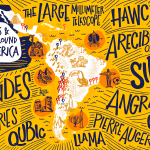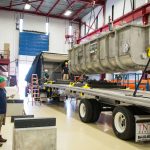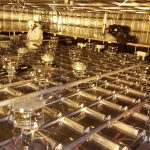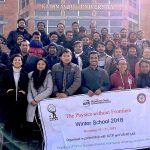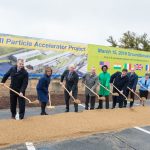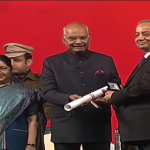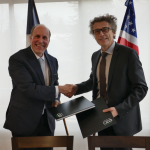From University of Colima’s El Comentario, Feb. 4, 2020: Alexis Solís Ceballos, estudiante de Ingeniería Química Metalúrgica en la Facultad de Ciencias Químicas de la Universidad de Colima, participó recientemente en una estancia de tres meses en el Fermi National Accelerator Laboratory (Fermilab) de Estados Unidos, donde un grupo de científicos de todo el mundo explora las altas energías para responder preguntas fundamentales que ayudarían a entender mejor cómo funciona el universo.
internationality
Latin America has reached a pivotal moment in experimental particle physics and astrophysics research. Throughout the month of October, Symmetry will highlight important places, explain significant milestones, and introduce you to some of the people who have shaped and are continuing to shape particle physics and astrophysics in Latin America.
The first major superconducting section of the PIP-II accelerator has come to Fermilab: the first of 23 cryomodules for the future accelerator. The cryomodules’ job is to get the lab’s powerful proton beam up and moving, sending it to higher and higher energies, approaching the speed of light. This first cryomodule also represents a successful joint effort between Argonne National Laboratory and Fermilab to design and produce a critical accelerator component for the future heart of Fermilab.
Physicists meet this week in Granada, Spain, to update the European Strategy for Particle Physics. Hundreds of scientists from around the globe associated with the European particle physics program are meeting ti discuss and evaluate what Europe’s next collaborative projects should be. The end goal is a consolidated strategy that European research institutions can use to guide their efforts for the next several years.
From WDCB’s First Light, March 24, 2019: Brian O’Keefe interviews Fermilab PIP-II Project Director Lia Merminga about PIP-II, an accelerator project critical to the lab’s future. Fermilab broke ground on PIP-II on March 15. Learn about how PIP-II will power the international Deep Underground Neutrino Experiment, hosted by Fermilab, and the lab’s experimental program in this 15-minute piece.
On March 15, Fermilab broke ground on PIP-II, a major new particle accelerator project at Fermilab. Dignitaries from the United States and international partners celebrated the start of the project at the groundbreaking ceremony. The PIP-II accelerator will power the long-term future of the laboratory’s research program, including the international Deep Underground Neutrino Experiment and a suite of on-site experiments.
Agencies in the United States and France have signed statements expressing interest to work together on the development and production of technical components for PIP-II, a major particle accelerator project with substantial international contributions. In addition, the French agencies also plan to collaborate on DUNE, an international flagship science project that will unlock the mysteries of neutrinos.

